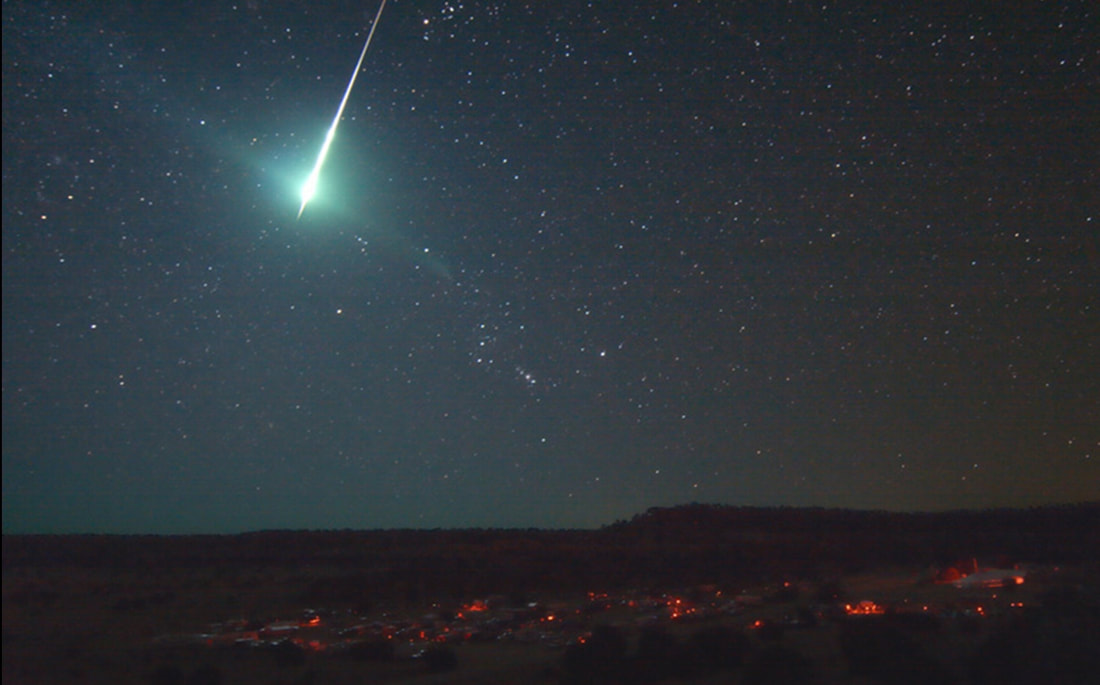 Meteor
Meteor
Meteors
The most notable meteor shower in December is the Geminids, which often produce brilliant fireballs. Unlike most meteor showers which are associated with the path of a comet, the originator of the Geminids appears to be an asteroid. As the Moon is an 8-day old evening crescent at the time of maximum activity, observing conditions are favourable.
Another interesting shower is the Phoenicids. This shower appears to be subject to outbursts of intense activity followed by lengthy periods in which little activity is observed. On December 5 1956, observers in New Zealand, Australia, the Indian Ocean and South Africa saw about 100 meteors per hour, including very bright fireballs, arriving from the constellation of Phoenix. Since that time only a small number of meteors have been observed from this radiant. The cycle of activity of the Phoenicids is not known and another outburst could occur in any year.
The other large shower at this time of the year is the Quadrantids. The shower radiates from the northern region of Bootes, an area of the sky that was once occupied by the constellation of Quadrans Muralis. Although this constellation has now been abandoned, the meteor shower retains its ancient name. The Quadrantids meteors are as numerous but not as bright as the other two large showers.
On the chart below ZHR is the zenith hourly rate. This is the number of meteors visible to the unaided eye per hour to be expected when the radiant is at the zenith (directly overhead) at a dark sky site. This is an ideal situation, which is rarely achieved.
Shower Activity Maximum ZHR
Phoenicids Nov 28 - Dec 09 Dec 02 100*
Puppid-Velids Dec 01 - Dec 15 Dec 07 10
Leo Minorids Dec 05 - Feb 04 Dec 20 5
Geminids Dec 07 - Dec 14 Dec 15 120
Quadrantids Dec 27 - Jan 11 Jan 04 110
Centaurids Jan 31 - Feb 20 Feb 08 6
* This is approximately the number of meteors seen in 1956. At other times the number is much lower.
The most notable meteor shower in December is the Geminids, which often produce brilliant fireballs. Unlike most meteor showers which are associated with the path of a comet, the originator of the Geminids appears to be an asteroid. As the Moon is an 8-day old evening crescent at the time of maximum activity, observing conditions are favourable.
Another interesting shower is the Phoenicids. This shower appears to be subject to outbursts of intense activity followed by lengthy periods in which little activity is observed. On December 5 1956, observers in New Zealand, Australia, the Indian Ocean and South Africa saw about 100 meteors per hour, including very bright fireballs, arriving from the constellation of Phoenix. Since that time only a small number of meteors have been observed from this radiant. The cycle of activity of the Phoenicids is not known and another outburst could occur in any year.
The other large shower at this time of the year is the Quadrantids. The shower radiates from the northern region of Bootes, an area of the sky that was once occupied by the constellation of Quadrans Muralis. Although this constellation has now been abandoned, the meteor shower retains its ancient name. The Quadrantids meteors are as numerous but not as bright as the other two large showers.
On the chart below ZHR is the zenith hourly rate. This is the number of meteors visible to the unaided eye per hour to be expected when the radiant is at the zenith (directly overhead) at a dark sky site. This is an ideal situation, which is rarely achieved.
Shower Activity Maximum ZHR
Phoenicids Nov 28 - Dec 09 Dec 02 100*
Puppid-Velids Dec 01 - Dec 15 Dec 07 10
Leo Minorids Dec 05 - Feb 04 Dec 20 5
Geminids Dec 07 - Dec 14 Dec 15 120
Quadrantids Dec 27 - Jan 11 Jan 04 110
Centaurids Jan 31 - Feb 20 Feb 08 6
* This is approximately the number of meteors seen in 1956. At other times the number is much lower.
Page Modified 12/12/2019